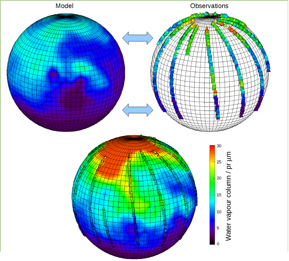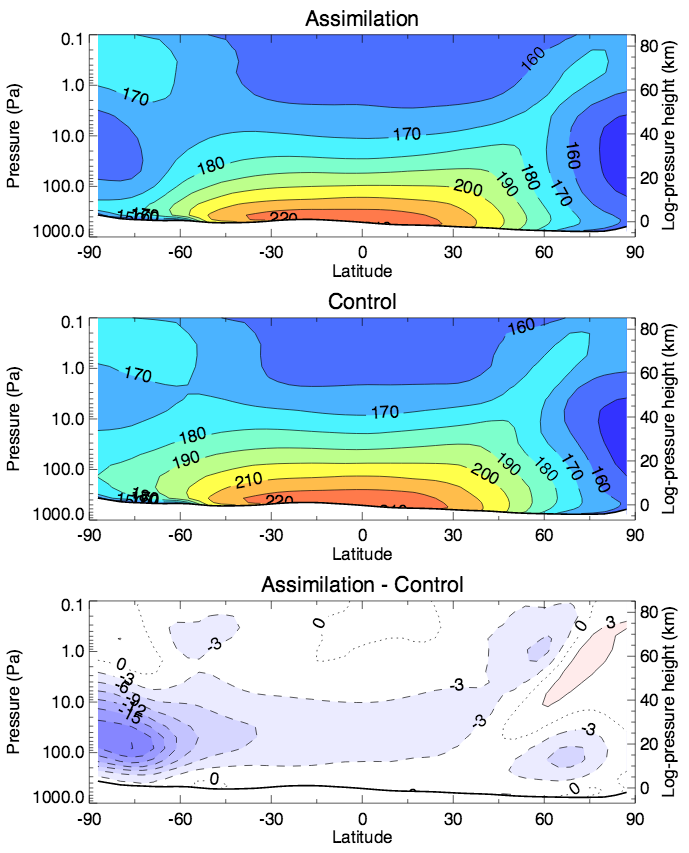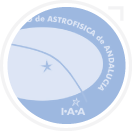Martian climate
Data assimilation is a technology widely used in geosciences (especially meteorology and weather forecasting), enabling an optimal reconstruction of a best estimate of the atmospheric state. It consists of the combination of observations and numerical models, which (a) provide physical constraints, (b) organize and propagate the observational information which is introduced and (c) enable the recovery of variables not directly measured. In Earth atmosphere science, data assimilation is systematically used to provide climatologies derived from space-based observations. Data assimilation for Mars has been proposed for some time, but it has only more recently that it has been shown to be successful in practice, with new and more complete data sets from NASA Mars Global Surveyor

More recently, advanced ensemble data assimilation techniques have also been developed. These techniques follow developments in Earth data assimilation for weather forecasting and reanalysis purposes, but require specific tuning and developments to apply to Mars in a situation where most of the time data comes from a single orbiting spacecraft. The objectives of the UPWARDS data assimilation project are threefold:
- Apply our existing, well proven assimilation scheme (“Analysis Correction Scheme”) to produce an extended analysis of all available data from three NASA spacecrafts (MRO, Mars Odyssey, MO, and Mars Global Surveyor, MGS) to provide the community with a reference “reanalysis” which will be used to cross-validate new assimilation scheme.
- On this basis, develop a new state-of-the-art data assimilation method (Local Ensemble Transform Kalman Filter, LETKF) with the final objective of performing near-real time assimilation of the TGO meteorological observations. This new method will be tested and validated by combining MEx and MRO meteorological data. Such real-time assimilation will in particular permit the reconstruction of winds, making it possible to back-trace minor gas trajectories, and therefore locate their sources, a prime objective of TGO.
- Develop the novel ability to assimilate trace species, including water and ozone. The study will focus on mapping water and ozone, as has very recently been shown to be possible for Mars, in the UK version of the state-of-the-art LMD Mars GCM using the proven semi-Lagrangian tracer advection scheme and the analysis correction data assimilation scheme, together with the most recent version of a fully coupled photochemical model.

The synthesis of different data types will not only produce a regularly sampled record of use to a wide variety of scientific and engineering disciplines, but will maximize the potential recovery of information from e.g. trace species measurements by combining them with model winds, which will in turn be influenced by the impact on thermal observations. The development of new data assimilation techniques specifically tuned for ExoMars TGO observations will prepare for and maximize the scientific benefits of that mission.
A previous assimilation using only thermal and total dust opacity data from the NASA Mars Global Surveyor spacecraft has demonstrated the applicability of this technique with data in a fully-documented portable format at the British Atmospheric Data Centre. UPWARDS will include more recent thermal and opacity data from NASA Mars Reconnaissance Orbiter (MRO)/Mars Climate Sounder, water and trace species information in the form of ozone observations from Mars Express/SPICAM and MRO/MARCI. These data will be archived in Planetary Data System (PDS) format on the ESA Planetary Data Archive.
Summary outcome: 4-D mapping from diverse assimilation products combining Mars Express and other Mars missions, and including trace species.
Dedicated Work Package: WP8
Links to other UPWARDS activities: WP4, WP5, WP6, WP9
Related papers
Banfield et al., J. Atmos. Sci., Vol. 52, pp. 737–53 (1995)
Lewis, S. R. and Read, P. L.,Adv. Space Res., Vol. 16, pp. 9-+ (1995)
Lewis et al., Icarus, Vol. 192, pp. 327-347 (2007)
Montabone et al. ,Icarus, Vol. 185, pp. 113-132 (2006)
Greybush et al., J.Geophys. Res., Vol. 117, E11008 (2012)
Steele et al., submitted to Icarus (2014)
Steele et al., paper presented at The 5th International Workshop on the Mars Atmosphere: Modelling and Observation, Oxford, UK (2014)
Holmes et al., paper presented at The 5 h International Workshop on the Mars Atmosphere: Modelling and Observation, Oxford, UK (2014)
Lewis et al., Icarus, Vol. 192, pp. 327-347 (2007)
Montabone et al., paper presented at the 5thInternational Workshop on the Mars Atmosphere: Modelling and Observations, Oxford, UK (2014) 105http://badc.nerc.ac.uk/view/badc.nerc.ac.uk__ATOM__DE_095e8da2-cf02-11e0... McCleese et al., J.Geophys. Res., Vol. 115, E12016 (2010)
































